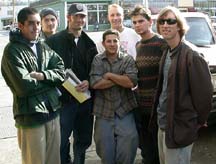|
story & photos by ANDREW EDWARDS
Slowly the camera moves up and it becomes clear that what appeared to be a body of water is really a highly varnished table. A man reading at the table is in high relief against the night sky out the window behind him, the whole scene enveloped in a frame of black. Suddenly the scene becomes a swooping angular shot of the same table, without the man, in daylight; then jumps again to rolls of glowing green microfiche sliding back and forth. Gary Sommers getting into character. "I would usually never let anyone see my roughs," said cinematographer River Hagg, 29, referring to the unedited footage on a high definition digital monitor. "But we're coming away with gorgeous stuff every day." It's a Monday night in the production office of Just Add Water Productions, in what used to be the offices of the World Premier Theatre, over Lost Coast Brewery in Eureka. The footage is from the group's latest effort, Escape in Time, currently filming in Humboldt. Behind River, the film's director, Gulliver Parascandolo, 23, is playing the latest installation of the Command and Conquer video-game series on the company's one working computer with his right-hand man, assistant director Mike Romero, also 23. Down the hall, in the theater itself, art director Samantha Summers is sitting on the floor putting the finishing touches on an Alcatraz jail cell set, listening to rap out of a boom box propped on the cell's pinstriped mattress. Behind her a huge concave fluorescent green-screen for shooting special effect shots dominates the room. It is a rare moment of repose for a film crew that has been shooting non-stop since the beginning of November and plans to continue, with a brief break for Thanksgiving, well into December. In the end the shoot will have lasted 30 days, at a cost of more than $60,000 and not a few sleepless nights. The genesis of EscapeMaking an independent film is somewhere between an act of will and a leap of faith. It is a huge, incredibly complicated task requiring hundreds of hours of labor from people who are getting paid little or nothing at all. Just to get the whole thing going, someone's belief in the project has to border on the fanatical.
[Gulliver Parascandolo watches the monitor as cast and crew look on.] He wrote the story that would become the seed for Escape in Time in 1978, loosely basing it on his life at the time. He had thought from the beginning that it would make a better movie than story, but decided to sit on it. Fifteen years later he decided to drag it out with the intention of reworking it. But he decided it wasn't salvageable. "It was so bad I threw it away," Ron said. He ended up rewriting the whole thing, this time as a novella. It was never published, but it served as the basis for the film's script (hashed out by Ron, Gulliver and local writer Ron Romanowitz). What is the story about? Well, it follows an introverted Humboldt State University janitor and struggling writer named Jon Ramsey (local actor Gary Sommers), who begins having vivid dreams about Jon Anglin (Sommers again), a violent bank robber and Alcatraz inmate who bears a striking resemblance to him. The dreams and the suicide of a [River Hagg and his digital camera.] "Ultimately the movie is about dreams," River said. "Realizing your dreams and why you're here, the importance of recognizing them and going forward to pursue them." Historically, Jon Anglin, his brother Clarence and fellow inmate Frank Morris did escape from Alcatraz in 1962, and though their bodies were never found they were presumed drowned in San Francisco Bay. The genesis of WaterAfter trying out careers from crab fishing in the Bering Sea to semi-professional skateboarding, Ron's son River ended up in the film industry. He got his start doing skateboarding and surfing videos (River is actually the surfer double for Sommers in Escape in Time), and moved on to commercials and free-lance work. River started his first production company, Ones and Zeros, with a camcorder and a dream in San Francisco in 1996. After that fell through he joined the Navy and was stationed on the aircraft carrier the USS Constellation out of San Diego. When he got out he started looking around for something to do. He was considering going into real estate when his wife, Marisol Roman, suggested that he try to start up another production company. Just Add Water was the result. Meanwhile, Gulliver had moved to San Diego after attending film school at Trident University in Charleston, S.C. He is one of those people who has always known what he wanted to do. He made his first film at age 10 on a camcorder. By age 13 he was in his first film festival, the American Film Institute's Visions Awards, where received a special recognition prize for his film Spamtastic.
At the time River, in addition to running Just Add Water, was working with a youth education program teaching kids how to shoot video as a means of artistic expression. He got Gulliver interested in the program, and in his film company. (Eventually, Gulliver would become a partner in Just Add Water.) [Above, Eddie Munster is a guest director on Escape In Time's clapboard. Right, Ron Hagg looks on at the North Jetty.] "We have very different styles but the same taste," Gulliver said. River said that they recognized complementary talents in each other. "Between me and Gulliver there's pretty much nothing we can't do," River said. "We're either crazy or really good," he added, laughing. The two have done several short films together, including a number of documentaries for political nonprofits in the San Diego area. Most recently, they did a surreal, eight-minute short called 12:02, about a man's life lived in two minutes. They were really looking for a chance to take the next step and make a feature-length film when River's dad proposed the idea for Escape in Time. "There are [only] so many shorts that a person wants to do before they move on to the next level," River said. Ron had been working the script over in his mind since writing it, thinking over locations, and had asked Sommers if he would play the lead. Finally, Gulliver traveled up late last summer to scout out locations, and the Just Add Water team went to work making Ron's dream -- not to mention their own -- a reality. Challenges, logistical and otherwiseThey faced several challenges, the first being the ambitiousness of the project they were embarking on. "For an independent film everything we're doing is uncommon. For instance, we picked a location-intensive film, a cast-intensive film," River said. "We picked a really hard story to do." Most classics of the indie genre such as Clerks, shot entirely in and around one convenience store, or Reservoir Dogs, filmed mostly in one warehouse, have just one or two locations, while Escape in Time has almost as many locations as there are days of shooting. It was a daunting task. Recruiting the cast and crew, at least, was remarkably easy. "It wasn't hard to get a cast and a crew and everything together," said Sommers, who was recruited for his role in the very early stages, and got to watch the whole thing come together. "People came out of the woodwork; people came from everywhere." After two casting calls, the first in July and the second in early October, where more than 200 would-be stars showed up to try out, they had the movie pretty well stocked with actors. "We're proud that about 90 percent of everyone who auditioned is somewhere in the movie," Gulliver said. If someone didn't get the part they read for they were asked if they could come back as extras. Since they began filming on Nov. 5, shooting has been proceeding on schedule, a remarkable achievement for any film. From dealing with beggars to herding drunks on the Plaza, to cursing at planes flying overhead, to trying to squeeze in that last shot before sundown, shooting a film is a constant struggle. People wander in, asking questions. Passers-by shout out encouragement or random comments. [Right, Assistant Director Justin Ladd works the smoke machine in Sidelines.
"Let's put some truth in here; you all have come in here and interfered with my ability to make a living," he kept repeating. Eventually one of the crew gave him $5 to go away. Sometimes the hang-ups are a little more serious, as when Sommers nearly drowned while they were shooting a night swimming scene in Humboldt Bay. "I was swimming out when my body just stopped working and I started to sink," Sommers recalled. Luckily River was swimming -- and filming along with him, and was able to grab him and pull him to a spot where he could stand up and walk to shore. "But I got the shot," River said. Veteran stage actorAbove and beyond risking life and limb, the person who probably has the most invested in the project is Sommers, the star of the film. On the North Jetty of Humboldt Bay during a day of shooting earlier this month, Sommers seemed oblivious when approached, just looking down and walking on, waves crashing around him. Later, after the crew and filming had finished up for the day, he explained that he hadn't meant to be rude. "I'm sorry about that; I didn't mean to blow you off back there, I was just getting in character," Sommers said. This is actually Sommer's third film appearance. The first was in Outside the Box, an HSU student film done seven or eight years ago. More recently, he was in The Majestic, where his one line, "You've lived here all your life?" ended up on the cutting- room floor. Sommers, 49, has been acting for nearly 20 years in local productions. He got his start when some friends suggested he take a children's theater class at College of the Redwoods. After that he got what he called "the bug" and has been in, by his own estimate, 50 or 60 plays since. He said acting in a movie has been quite a switch. Instead of moving about a stage in front of a live audience he has to play to a camera. Instead of acting big so people in the last row can see what he's doing, the performance has to be tightened down, with sometimes only eyes and facial muscles telling the story. One direction he's gotten a lot is to keep his mouth shut. People usually have their mouths open a little, but it doesn't look good magnified on film. Also, in a play the action all proceeds in order, chronologically, but in filmmaking shots proceed in whatever order they are filmed, which often has nothing to do with the order they will appear in the finished movie. "At times it's just the camera on me with some thought in my head, thinking about what just happened to me, and we haven't even shot what just happened to me, so I have to create that," Sommers said. Sommers said that acting for him has always been more than just a hobby. In fact, after the film he plans to pull up stakes, quit his job as a carpenter, rent out his house and move to Southern California with his young son and partner to make it as a professional actor. He said his goal is to be one of those guys that you see in every movie but don't really know who they are, rather "If you can do what you love to do in this life, it doesn't get any better than that," Sommers said. "So I'm gonna give that a shot, before I die." [Alexandra Gellner as Michelle.] Another actor who sees career potential is Gellner, who plays a student driven to suicide. It is her first film and nearly first acting experience. Like her character, she is an athlete and a high achiever. At 15, she is on the varsity swim team at Arcata High and is a pianist for the ArMack Orchestra. She says she's still a little young to decide what she wants to do with the rest of her life. "Maybe acting is something I'm looking at [as a career], or maybe dermatology or some kind of doctor," Gellner said. "I'm not sure what I want to be. I'm a sophomore." For most of the supporting actors, Escape in Time is less a career move than a chance to see themselves on the silver screen. "I really, really hope I don't embarrass myself," said James Hitchcock, an Arcata accountant who plays Dave, Jon's co-worker and the film's comic relief. The crewBehind the camera is another group of dedicated individuals. Romero, the assistant director, came up from San Diego with Just Add Water to make the film. "Having [a crew member] who can't go home has its advantages," River quips. Romero, along with almost everyone else on the set, has multiple titles. Beyond assistant director, he is an assistant cinematographer, grip, gaffer and general pack mule. Other core crewmembers include Rowdy Kelly, at 35 one of the few "professionals" working in the film (he used to work for Channel 3 news in Eureka), who is set location manager, among other things; Gil Anderson, their "miracle grip" as Ron describes him; Evan Wrye on boom; and ReNey Smith, the ubiquitous makeup artist. Many were recruited from Humboldt State University's film program, but some, such as Anderson and Kelly, simply wanted to work on the film. They are all there nearly every day, working long, hungry hours (they eat an average of once a day). River said all would be happy if someone would volunteer to supply celery and peanut butter, so they'd at least have something to eat -- "We're starving for art," he said. River and Gulliver pride themselves on allowing the crew to do as many tasks and have as much creative input as possible. "We're really just creating a resource for ourselves" that the company can draw on again, River said. No one is getting paid in the traditional sense; instead, everyone is on a percentage system. Depending on the number of hours and the level of input, each crew member will receive a percentage of the movie's profits, assuming it ever turns one. Compensation aside, the crew appears happy, if a little haggard. Twenty-one-hour shooting days (sometimes 4 a.m. to 1 a.m. the next day) will do that to you. On setOn set they all work together with an intense focus and drive -- and with a level of coordination that borders on the machine-like. Gulliver, as director, is a sort of avatar of the film; the movie itself come to life. Barbara Domanchuk, a local producer doing a documentary of the film-making process who was on the Escape set recently, put it this way: "The director is god." "Quiet on the set! And ... action!" Gulliver says, and then stands or sits intently watching the monitor, which shows exactly what the new JVC-DV 700 Cineline digital camera is picking up. River works the camera, with the rest of the crew huddled around in assistance, moving the dolly, recording the sound, holding up reflectors. Ron sits off to the side, sometimes helping, sometimes dealing with passers-by and sometimes just sitting and fretting like an expectant father. Meanwhile the actors play out their scenes, sometimes only inches away, but in a different world mentally, Gulliver's world. After each take he shouts encouragement, offers advice, or confers with River about the technicalities of the shot (leaning over the camera discussing focal planes, angles, irising, booms, framing) and then it's either another take or on to the next scene. Overall the crew seems to have an immense amount of respect for the young filmmaker, using terms like talented, driven and sometimes even genius. "He's cool under pressure, and he has a vision of what he wants to see," said Anderson, the grip. "I think we're going to be seeing him doing some major films in the years to come." Tarantino, Scorsese, Stone, Ford-Coppola, Speilberg, Parascandolo and Hagg? Maybe, maybe not. "We're going to give you something that you've never seen before," River said. In an art form that's always looking for the next big thing, that's saying something, bravado or not. The digital techniques that they are using in the film, including reshooting a green- screen to cut and paste actors' performances, are, if not new, certainly cutting-edge. "We are on the leading edge of the digital revolution," both River and Gulliver are fond of declaring. The duo said that a film this ambitious could never have been made for less than a million dollars, even as little as two years ago. The digital camera means no film, and none of the processing and transfer costs that go along with it. They will be able to edit the movie and add special effects at a high-end desktop computer, instead of renting expensive editing equipment. On their budget of $60,000, most of it paid with credit cards, they were able to buy all of their equipment, so that even if they ran out of money they could continue making the film. `A major pipe dream'But even at that relatively minuscule cost, it can be a financial hardship on this small a level. "This is a major pipe dream for Ron and I hope it works out for him," said Hitchcock during a break between scenes. "He has more than blood, sweat and tears in this thing." It's possible the film could turn a profit. "The only way you can really go wrong with a film is to give [the filmmakers] too much money," said Emmy-winning writer Jack Hanrahan, waiting to go on for a part he has as an alley-way "spanger." "And they certainly haven't done that here." He said that foreign distribution and video alone could return a small production cost in spades, even if nothing works else works out. The Haggs and Gulliver are hoping to do more than just break even, however. Their aim is to get the finished film into Robert Redford's Sundance Film Festival and eventually have it distributed nationally. Will it happen? Only time will tell. Gulliver said that they hope to have the film finished by next summer. So expect Escape in Time to appear in a local theater shortly after that, as they plan to do the first showing in Humboldt County. "We are going to be a force for years to come," River vowed.
From left to right, boom operator Evan Wrye, Assistant Director Justin Ladd, Location Manager Rowdy Kelly, Assistant Director Mike Romero, Cinematographer River Hagg, Director Gulliver Parascandolo and grip Gil Anderson. Film TerminologyDIRECTOR: More than any other person, makes the movie. Responsible for the film's overall look and feel, as well as guiding the actors' performances. CINEMATOGRAPHER: Aka the director of photography, the person in charge of getting the director's vision recorded visually; oversees all camera operations, lighting etc. PRODUCER: Person who gets together the financing and crew to create the movie. Facilitates the artistic process. ART DIRECTOR: Person responsible for making all props and sets as well as making sure everything in the film looks authentic; responsible for the physical look of things in the film. GRIP: Responsible for taking care of equipment on a movie set. GAFFER: Chief electrician, responsible for all cords, lighting and power on the set. BOOM OPERATOR: Holds the microphone boom to record sound during filming. PRODUCTION ASSISTANTS: Those who make sure that any of the work of any of the principal crew proceeds with minimal effort and hassle. IN THE NEWS | IN THE GARDEN | GOOD NEWS | CALENDAR
Comments? E-mail the Journal: [email protected] © Copyright 2002, North Coast Journal, Inc. |

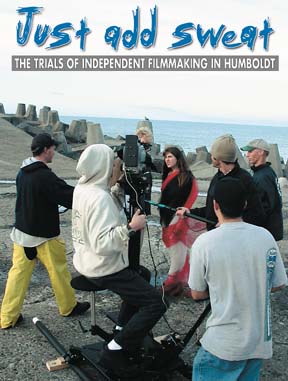
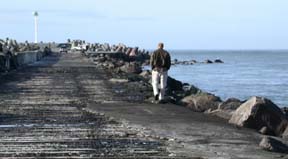 THE SHOT SKIMS OVER A SHIMMERING BLACK POOL.
THE SHOT SKIMS OVER A SHIMMERING BLACK POOL.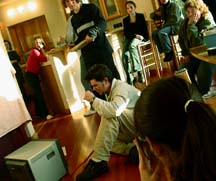 In this case that someone is River's father, Ron Hagg, who is serving as the film's producer and chief financial backer. Hagg, a local teacher, writer, surfer and photographer, is a thin, energetic man with bright blue eyes and an easy smile.
In this case that someone is River's father, Ron Hagg, who is serving as the film's producer and chief financial backer. Hagg, a local teacher, writer, surfer and photographer, is a thin, energetic man with bright blue eyes and an easy smile. kindred spirit, a young swimmer named Michelle (played by 15-year-old Arcata High student Alexandra Gellner), combine to break Ramsey down mentally, eventually freeing him from the emotional prison he has erected for himself. Meanwhile, in his dreams, his alter-ego Anglin escapes from prison as well, literally.
kindred spirit, a young swimmer named Michelle (played by 15-year-old Arcata High student Alexandra Gellner), combine to break Ramsey down mentally, eventually freeing him from the emotional prison he has erected for himself. Meanwhile, in his dreams, his alter-ego Anglin escapes from prison as well, literally. He went through several jobs in San Diego until he met River while working as an editor for Down Town Productions, a film production outfit that did commercial spots for non profits (River did some free-lance work for the group).
He went through several jobs in San Diego until he met River while working as an editor for Down Town Productions, a film production outfit that did commercial spots for non profits (River did some free-lance work for the group).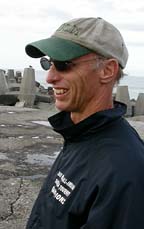
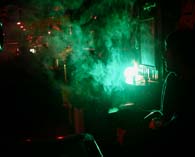
 One dreadlocked man in a blue windbreaker and fisherman's hat continually followed around the film crew saying that their motorhome had interfered with his work. Apparently they had parked it right in front of his "spanging" (begging, a conjugation of spare and change) spot in front of Arcata Pizza and Deli.
One dreadlocked man in a blue windbreaker and fisherman's hat continually followed around the film crew saying that their motorhome had interfered with his work. Apparently they had parked it right in front of his "spanging" (begging, a conjugation of spare and change) spot in front of Arcata Pizza and Deli. than someone who can't go out to eat without being mobbed by the paparazzi.
than someone who can't go out to eat without being mobbed by the paparazzi.